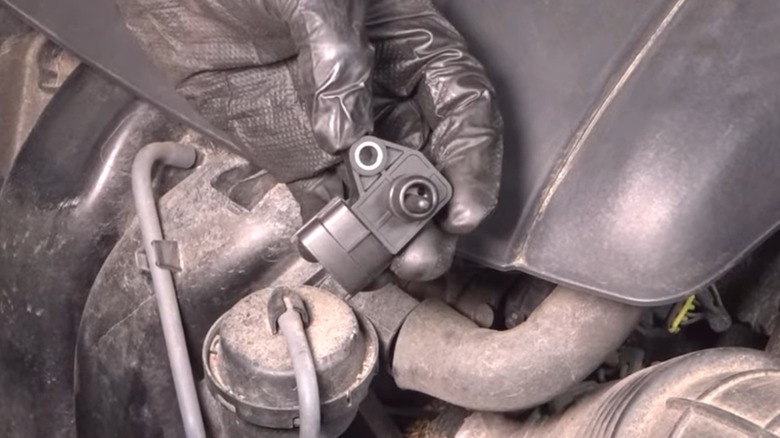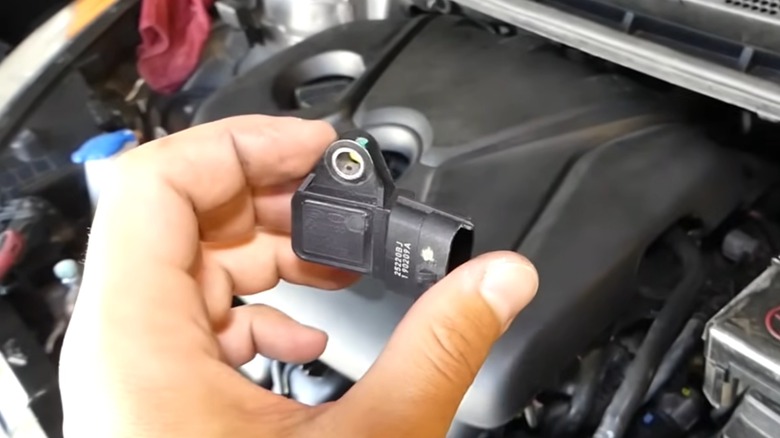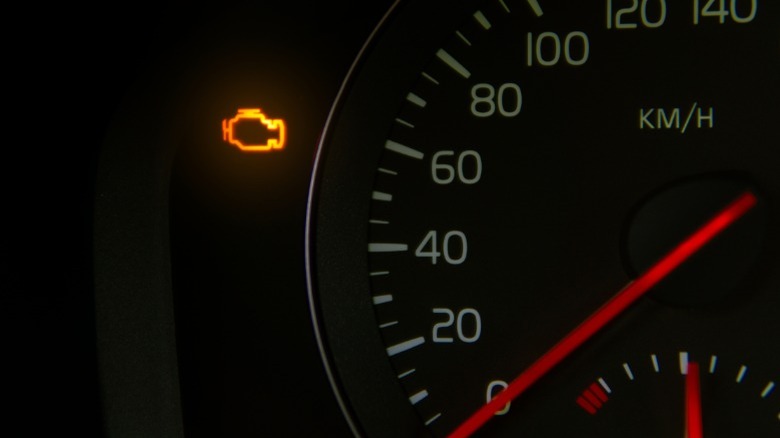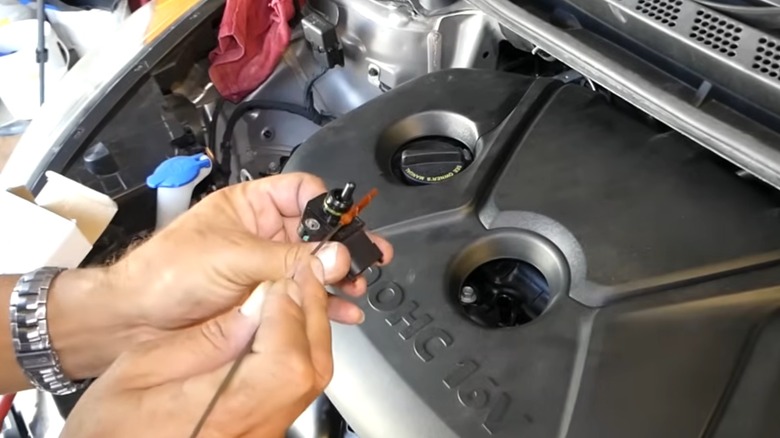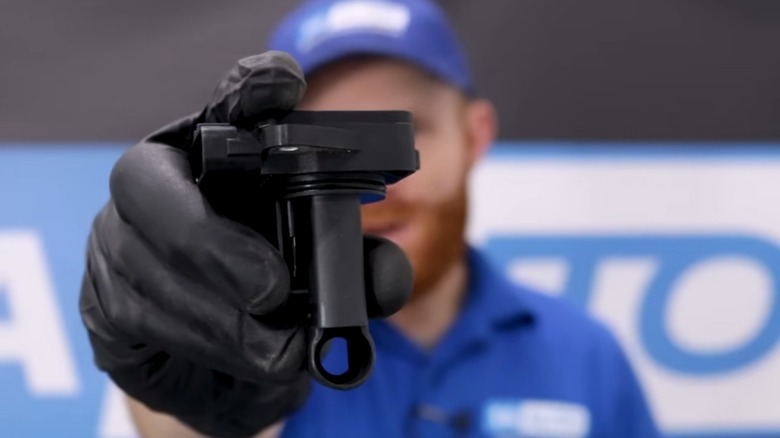What Your Car's MAP Sensor Does (And How To Tell If It Is Failing)
Modern vehicles rely on a massive amount of electrical systems, sensors, and control modules to keep the wheels turning. Some of those devices are well-known, like your car's main computer or engine control module (ECM), which helps control things like fuel injection, ignition timing, and various other actions. Other electrical components are less-well known, despite having equally critical responsibilities. One such part is the manifold absolute pressure or MAP sensor.
The MAP sensor is responsible for monitoring the air entering the engine through the intake manifold. That's important because internal combustion engines require a precise combination of air and fuel to create the small explosions that give your car its power. The MAP sensor monitors the air pressure inside the engine's air intake manifold and sends that data to the ECM. The computer then uses the information to augment the amount of fuel that the engine receives, optimizing engine performance and efficiency.
That's a basic breakdown of what your car's MAP sensor does. However, if you're interested in learning more about how the sensor works, signs that it's gone bad, and how much it costs to replace, I've got you covered. As a former professional auto repair technician and a lifelong gearhead, I'll break it all down. Let's dive in and explore all the things you need to know about your car's MAP sensor.
How does your car's MAP sensor work?
As mentioned, the MAP sensor is usually located on the engine air intake manifold near the throttle body. As air passes through the manifold to reach the combustion chambers, the sensor collects critical data about the air pressure. Because the pressure inside the manifold can change based on driving conditions, the sensor must constantly send data to the ECM. The MAP is able to do this thanks to its construction.
Inside, it contains a flexible chip. When the pressure inside your intake manifold is high — like when you're pressing on the gas pedal — that chip flexes, creating an electrical signal that causes the ECM to send more fuel to the engine. However, when the pressure inside the manifold is low — like when you're decelerating — the sensor's chip returns to its normal state, causing the ECM to send smaller amounts of fuel to the engine. The MAP sensor monitors the air that enters through the intake system, but it can also detect positive or external pressure, meaning it can alert the computer if there's a leak in the system or the throttle body doesn't close properly.
It's a relatively complicated system, and the ECM doesn't rely only on the MAP sensor to accomplish these feats and adjust the engine. In reality, your car's computer uses information collected from various sensors. These include the MAP, intake air temperature (IAT), and engine coolant temperature (ECT) sensors, to fine-tune your engine and help it run properly.
What are the signs of a failing MAP sensor?
Your car's MAP sensor is a vital part of its electrical and air intake systems. If it fails, it can cause some pretty annoying and, potentially, costly issues. Fortunately, if you replace a faulty MAP sensor quickly enough, you can avoid most serious problems. You will need to be able to recognize the symptoms of a failing MAP sensor, though, so let's check some of the most common signs.
One of the first symptoms that you may notice if your MAP sensor goes bad is a check engine light. Your car can display a lot of dashboard warning lights, but the check engine light or CEL is one of the most well-known and concerning. It appears when your car's onboard diagnostic (OBD) system detects a malfunction with a component, and it provides diagnostic trouble codes (DTCs) that help you identify and diagnose the source of the problem. The light may appear if your MAP sensor begins sending incorrect or erratic data or stops working altogether. However, many issues can cause the check engine light to appear, so you'll need a mechanic's help or an OBDII code reader to diagnose the problem.
Besides a check engine light, if your MAP sensor goes bad, you'll also probably experience a few additional performance issues. You may notice that your car's gas mileage decreases, or your engine may start misfiring, idling roughly, or stalling. Alternatively, you may only discover that your car has a bad MAP sensor if your vehicle fails a SMOG test. None of these issues are good for your car, so if you experience any of them yourself, you should visit a professional mechanic as soon as possible to address the problem and prevent further damage.
How much does it cost to replace a car's MAP sensor, and can you DIY the fix?
Now that you know what the MAP sensor does and why it's so important, you may be wondering if it's an expensive part to replace and whether or not it's something you can do yourself. First of all, replacing a MAP sensor is relatively inexpensive, especially compared to other automotive repair jobs. A new sensor will generally cost between $50 and $200, depending on your car and where you buy the part.
If you visit a professional repair shop for the service, you'll also have to pay for the mechanic's labor time. Replacing the MAP sensor is relatively simple and quick, but it will still probably take between half an hour and two hours, depending on the vehicle. Most shops charge anywhere from $50 to $150 per hour, so you could be looking at a total cost between $100 and $350 for your MAP sensor replacement.
But what if you want to replace the sensor yourself? In that case, you'll be able to save on labor costs, and you may even be able to get the part for cheaper if you buy it yourself. Replacing your own MAP sensor is possible, even if you're a car novice. It generally requires access to only basic tools, and if you follow the right guide or own a vehicle-specific repair manual, you should be able to complete the replacement with ease.
What's the difference between a MAP sensor and a MAF sensor?
You can frequently find MAP sensors on modern fuel-injected vehicles. However, it's often more common to see mass airflow or MAF sensors. Like MAP sensors, MAF sensors monitor the air flow entering the engine. But while your car's MAP sensor is located on the intake manifold near the throttle body, the MAF sensor is usually connected to the vehicle's air intake tube between the air filter and the throttle body. The MAP sensor monitors air pressure inside the manifold and detects leaks and other abnormalities. In comparison, the MAF sensor measures how much air is entering the intake system and, depending on the car, can also track the air temperature. Both sensors provide important data to the ECM, helping it optimize the engine's performance.
Most contemporary cars have either a MAP or a MAF sensor. However, vehicles with forced induction technology, like a supercharger or a turbocharger, usually have one of each. If you're curious about the type of sensor your car has, you can check your engine bay for yourself, check your owner's manual, reach out to the dealership or a mechanic, or search for the information online.
